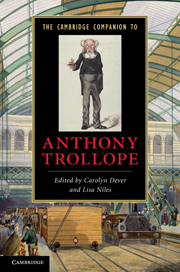Book contents
- Frontmatter
- Introduction
- 1 Trollope’s Literary Life and Times
- 2 Trollope As Autobiographer And Biographer
- 3 Trollope’s Barsetshire Series
- 4 The Palliser Novels
- 5 Trollope Redux: The Later Novels
- 6 Trollope’s Short Fiction
- 7 Trollope And The Sensation Novel
- 8 Queer Trollope
- 9 The hobbledehoy in Trollope
- 10 The construction of masculinities
- 11 Vulgarity and money
- 12 Trollope and the law
- 13 Trollope and travel
- 14 Trollope and the Antipodes
- 15 Trollope and Ireland
- 16 Trollope and America
- Further reading
- Index
- Cambridge Companions to . . .
2 - Trollope As Autobiographer And Biographer
Published online by Cambridge University Press: 28 March 2011
- Frontmatter
- Introduction
- 1 Trollope’s Literary Life and Times
- 2 Trollope As Autobiographer And Biographer
- 3 Trollope’s Barsetshire Series
- 4 The Palliser Novels
- 5 Trollope Redux: The Later Novels
- 6 Trollope’s Short Fiction
- 7 Trollope And The Sensation Novel
- 8 Queer Trollope
- 9 The hobbledehoy in Trollope
- 10 The construction of masculinities
- 11 Vulgarity and money
- 12 Trollope and the law
- 13 Trollope and travel
- 14 Trollope and the Antipodes
- 15 Trollope and Ireland
- 16 Trollope and America
- Further reading
- Index
- Cambridge Companions to . . .
Summary
Trollope began writing his autobiography towards the end of 1875 and finished it at the end of April 1876. It was not until summer 1878 that he told his son Henry. There was a letter with the manuscript, both to be read only after his death. In the letter he wrote that he wanted Henry to edit and publish it as soon as possible, and An Autobiography came out in two volumes from Blackwood in autumn 1883. Henry suppressed two passages critical of men still living and, in his preface, filled in the main events between the completion of the autobiography and his father’s death in December 1882, and listed the further books which his father had written.
As Trollope writes on the first page, his intention was not to reveal “the little details of my private life,” but to discuss what he and some of his contemporaries had achieved in literature, “and the opening which a literary career offers to men and women for the earning of their bread” (A ch. 1). He was always thinking of his influence on the young. He tells how he determined never to have any personal dealings with critics, neither to court or thank for praise, nor to argue over adverse criticism, “and this rule I would recommend to all young authors” (A ch. 4). He stresses that there is no shame in writing to make money, and that his example may show how “a man devoting himself to literature with industry, perseverance, certain necessary aptitudes, and fair average talents, may succeed in gaining a livelihood” (A ch. 6).
- Type
- Chapter
- Information
- The Cambridge Companion to Anthony Trollope , pp. 17 - 30Publisher: Cambridge University PressPrint publication year: 2010

